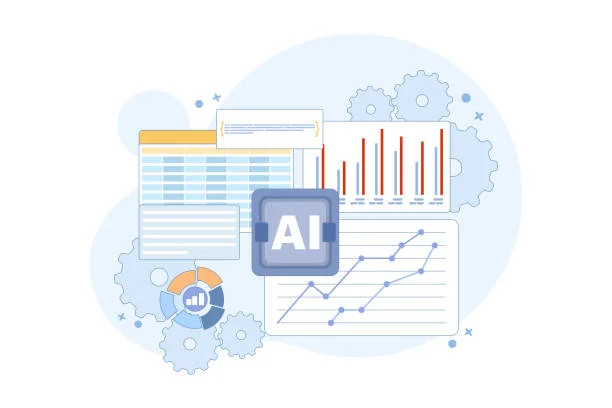For decades, Excel has served as the essential tool for managing data. From budgets and forecasts to highly sophisticated analytical models, Excel has aided professionals in structuring and viewing data efficiently. However, as datasets expand and decisions become more time-sensitive, working in Excel manually has only drained away time that could have been better spent. Time that could’ve been spared for getting to know some critical looks has instead been allotted for cleaning, sorting, or simply glancing at the data.
The solution is automation coupled with artificial intelligence. With the rise of AI-based data analytics, professionals find themselves having the option of moving beyond static spreadsheets to intelligent systems that perform data analysis, visualization, and reporting in real time. They do not simply work towards shortening workflows; they change the very essence of handling and understanding data.
Why Excel Alone Isn’t Enough Anymore
Traditional spreadsheets are limited by manual effort. Every piece of formula, pivot table, and graph requires time and human precision. Sometimes, minor changes in dynamic environments demand recalculations of sorts and restructuring of data, causing frequent errors or not providing timely insights to the analysts.
The manual way of working can slow down decision-making for market analysts and business leaders. When every update means reworking the data or reformatting reports, the opportunity cost eclipses fast. This is the reason organizations are now favoring AI data visualization tools that extend Excel capabilities and automate manual processes while still keeping a firm grip on data.
Automating Data Cleaning and Preparation
Data cleaning truly is one of the most time-intensive parts of any Excel workflow. Missing values, inconsistent formats, and undesired duplicate entries can take hours to rectify. AI handles it with ease. Pattern recognition and machine learning concepts are used by AI tools to detect anomalies, correct inconsistencies, and internalize unified data formats.
For example, instead of combing through errors in thousands of cells, the AI engine can scan entire datasets, clean them up, and validate them within minutes, thus enabling accuracy beyond doubt and allowing analysts to delve deeper into interpretation rather than data hygiene. This is the first massive step toward reclaiming the 200-plus analyst hours normally spent on spreadsheet upkeep.
Smart Insights Through Analysis with AI
Once the data is clean, the next step is analysis, and AI-based analysis of data makes this possible. Instead of creating formulas or pivot tables manually, the AI tools run contextual analysis to discover correlations and trends in the data. They can highlight the factors that have driven performance, uncover hidden relationships, or even recommend the next steps.
This goes far beyond Excel’s functions. For example, AI can automatically group customer data into categories based on behavior patterns or identify anomalies in financial performance without specifying the rules beforehand. A few clicks are all that is needed to generate narrative summaries and visual reports that explain “why” something happened, not just “what” happened.
Visualizing Data Intelligently
Visualization is where the real AI boost comes to Excel. AI tools for data visualization can automatically create interactive charts, graphs, and dashboards that update in real time. Users can thus skip hours of formatting and just concentrate on what they want to gain from the insight.
These tools allow natural language prompts from users into the system. Users can simply type questions such as “Show me quarterly sales by region,” and an animated chart corresponding to the query is generated. As new data comes in, the visuals on the chart race to adjust themselves. This interactive approach will convert Excel from a static spreadsheet into a living, evolving decision-support system.
Reducing Manual Reporting and Cost
Automation is one of the biggest advantages of integrating AI into Excel workflows in report generation. The tools can use multiple sheets to make inferences and prepare the reports for sharing within a few minutes. They also handle formatting, writing summaries, and creating visualizations.
This automation doesn’t save just time; it heavily cuts down on resources spent. AI-powered advanced analytics platforms have an upper capability of cutting down total analytics expense by 90%. What was previously an analysis done by whole teams spread over weeks can now be done in a fraction of the time with increased consistency and accuracy.
The evolution is well exemplified by solutions such as AskEnola. It automates data analysis, from beginning to end, converting spreadsheet chaos into structured data. By providing contextual insights and executive summaries from the data, it allows a professional to take quicker, data-backed decisions without relying on multiple tools or dashboards.
Transforming Excel into a Smart Assistant
Integrating AI into Excel changes how a user interacts with the data. Instead of navigating the cells and formulas, the user can simply ask a question in plain English. The system actively interprets intent and analyzes the data, providing instant visual summaries.
The idea here is to empower human analysts rather than to replace them. It is the AI that handles the repetitive, technical processes so that humans can focus on creativity, strategy, and decision-making. This gives the best of both worlds: speed from machines and context from people.
The Future of Excel with AI
AI is redefining what’s possible with spreadsheets. The familiar Excel environment remains, but its power expands dramatically with automation, intelligent insights, and dynamic visualization. Businesses that once depended on manual reporting are now making data-driven decisions at lightning speed.
With platforms like AskEnola leading this transformation, teams can finally move from hours of tedious spreadsheet maintenance to instant, actionable understanding. The age of manual Excel work is ending. The future belongs to those who use AI data visualization tools to turn static data into smart insights—and who see AI based data analytics not as an upgrade, but as the new foundation of intelligent operations.







